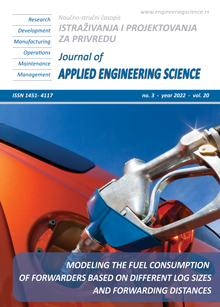EVALUATION OF THE PHYSICAL AND RHEOLOGY PROPERTIES OF RUBBERIZED ASPHALT CEMENT
Abstract
Asphalt cement is a viscoelastic substance that operates like an elastic solid at low service temperatures or under rapid loading. Whenever loaded slowly or at high temperatures, it behaves like a viscous liquid. This classic duality necessitates enhancing the efficiency of an asphalt binder to decrease stress cracking at cold temperatures (fatigue) and plastic deformation at hot temperatures (rutting). The use of polymer-modified asphalt binder is one solution for satisfying today's pavement performance standards. The purpose of this study was to determine the impact of asphalt cement modifiers on the physical and rheological properties of asphalt cement. This study used asphalt cement with a penetration grade of 40-50, modified with styrene-butadiene rubber (SBR) at four different levels of modification, specifically 0%, 2%, 4%, and 6% by weight of asphalt cement. Depending on Rotational viscosity and dynamic shear rheometer, and the traditional test. The mixes modified with SBR polymer showed enhanced physical and rheology characteristics, with decreased penetration and ductility and increased viscosity and softening point, as well as a lower rutting factor, indicating an increase in rutting resistance, according to the experimental data. The performance grade for original asphalt cement was 64-16, and for SBR at 2% additive, the original PG was improved to PG70-16. Adding 4% additive to asphalt cement improved the performance grade to PG76-16, and using 6% increased the performance grade to PG82-16.
References
Navarro, F., Martínez-Boza,F., Partal, P., Gallegos, C., Muñoz, M., Areizaga, J. and Santamaría, A. (2001). Effect of processing variables on the linear viscoelastic properties of SBS‐oil blends. Polymer Engineering & Science, 41(12): p. 2216-2225, https://doi.org/10.1002/pen.10917.>
Dong, R., Zhao, M. and Tang, N. (2019). Characterization of crumb tire rubber lightly pyrolyzed in waste cooking oil and the properties of its modified bitumen. Construction and Building Materials, 195: p. 10-18, https://doi.org/10.1016/j.conbuildmat.2018.11.044.>
Socal da Silva, L., de Camargo Forte, M.M., de Alencastro Vignol, L and Cardozo, N. (2004). Study of rheological properties of pure and polymer-modified Brazilian asphalt binders. Journal of Materials Science, 39(2): p. 539-546, https://doi.org/10.1023/B:JMSC.0000011509.84156.3b.>
[4] Li, R., Xiao, F., Amirkhanin, S., You, Z. and Huang, J. (2017). Developments of nanomaterials and technologies on asphalt materials–A review. Construction and Building Materials, 143: p. 633-648, https://doi.org/10.1016/j.conbuildmat.2017.03.158.>
Baochang, Z., Man, X., Dewen, Z., Huixuan, Z. and Baoyan, Z. (2009). The effect of styrene-butadiene–rubber/montmorillonite modification on the characteristics and properties of asphalt. Construction and Building Materials, 23(10): p. 3112-3117, https://doi.org/10.1016/j.conbuildmat.2009.06.011.>
Habbouche, J., Hajj, E., Sebaaly, P. and Piratheepan, M. (2020). A critical review of high polymer-modified asphalt binders and mixtures. International Journal of Pavement Engineering, 21(6): p. 686-702, https://doi.org/10.1080/10298436.2018.1503273.>
Wasilewska, M., Blazejowski, K. and Pecak, P. (2016). Effect of type of modified bitumen on selected properties of Stone Mastic Asphalt mixtures. in Proceedings of the International Conference on Road and Rail Infrastructure CETRA, http://master.grad.hr/cetra/ocs/index.php/cetra4/cetra2016/paper/view/605.>
Fernandes, M., Forte, M. and Leite, L. (2008) Rheological evaluation of polymer-modified asphalt binders. Materials Research, 11(3): p. 381-386, https://doi.org/10.1590/S1516-14392008000300024.>
Bates, R. and Worch, R. (1987). Engineering Brief No. 39, Styrene-butadiene rubber modified asphalt. Federal Aviation Administration, Washington, DC.
Tabatabaei, S.A., Kiasat, A. and Alkouhi, F. (2013). The effect of styrene-butadiene-rubber (SBR) polymer modifier on properties of Bitumen. International Scholarly and Scientific Research & Innovation, 7(10): p. 785-788, DOI: doi.org/10.5281/zenodo.1106973.
Zhang, H., Wang, H. and Yu, J. (2011). Effect of aging on the morphology of organo‐montmorillonite modified bitumen by atomic force microscopy. Journal of Microscopy, 242(1): p. 37-45, https://doi.org/10.1111/j.1365-2818.2010.03435.x.>
Bitumen, S. (1990). The Shell bitumen handbook, Shell Bitumen UK.
Liu, J., Yan, K., Liu, J. and Guo, D. (2019). Evaluation of the characteristics of Trinidad Lake Asphalt and Styrene–Butadiene–Rubber compound modified binder. Construction and Building Materials, 202: p. 614-621, https://doi.org/10.1016/j.conbuildmat.2019.01.053.

